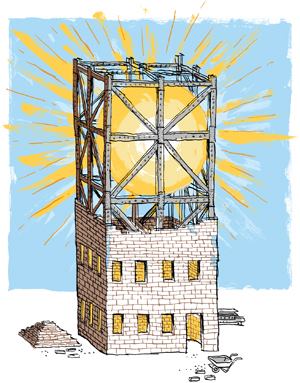LEED CREDITS FOR LIGHTING
(LEED for New Construction Version 2.2)
Sustainable Sites
Credit 8: Light Pollution Reduction
1 Point
Intent: Minimize light trespass from the building and site, reduce sky-glow to increase night sky access, improve nighttime visibility through glare reduction, and reduce development impact on nocturnal environments.
Explanation: This credit sets a limit for lighting power coming from an area or façade, for the amount of light crossing the property line based on lighting zone, and for light leaving the building through the windows, with an exception made for lights using an occupancy sensor.
Energy and Atmosphere
Credit 1: Optimize Energy Performance
1-10 Points
Two points mandatory for all LEED for New Construction Version 2.2 projects registered after June 26, 2007
Intent: Achieve increasing levels of energy performance above the base line in the prerequisite standard to reduce environmental and economic impacts associated with excessive energy use.
Explanation: This group of credits is where lighting can have the most impact. Designers can choose from a prescriptive method, which limits watts per square foot and includes mandatory control, or a whole-building energy simulation, which allows designers to achieve the maximum number of credits.
Indoor Environmental Quality
Credit 6.1: Controllability of Systems, Lighting
1 Point
Intent: Provide a high level of lighting system control by individual occupants or by specific groups in multi-occupant spaces to promote the productivity, comfort, and well-being of building occupants.
Explanation: This credit requires individual lighting controls for a percentage of a building’s occupants. Designers say this credit is one of the simplest to meet by adding task lighting in occupied areas.
Indoor Environmental Quality
Credit 8.1: Daylight and Views, Daylight for 75 Percent of Spaces
1 Point
Intent: Provide building occupants with a connection between indoor spaces and the outdoors through the introduction of daylight and views into the regularly occupied areas of the building.
Explanation: Although this credit does not directly affect electrical lighting systems, it does require that designers ensure that regularly occupied spaces receive certain levels of daylight. Designers can calculate the glazing factor, computer simulate the amount of daylight, or assess daylight through records of indoor light measurements.
Indoor Environmental Quality
Credit 8.2: Daylight and Views, Views for 90 Percent of Spaces
1 Point
Intent: Provide building occupants with a connection between indoor spaces and the outdoors through the introduction of daylight and views into the regularly occupied areas of the building.
Explanation: This credit requires outdoor views for a percentage of people in occupied spaces, which can be difficult in cubicle farms where the privacy needs are balanced with the value of the view. Two points can be achieved if both Credit 8.1 and Credit 8.2 are met.
Innovation & Design Process
Credit 1–1.4: Innovation in Design
1-4 Points
Intent: Provide design teams and projects the opportunity to be awarded points for exceptional performance above the requirements set by the LEED for New Construction Green Building Rating System and/or innovative performance in green building categories not specifically addressed by the LEED system.
Explanation: This credit is achievable by selecting lighting that is locally sourced or uses recycled materials. While lighting is exempt from the Materials and Resources credits that require regionally produced and recycled-content materials, designers get innovation credit by going further to include electrical lighting.
